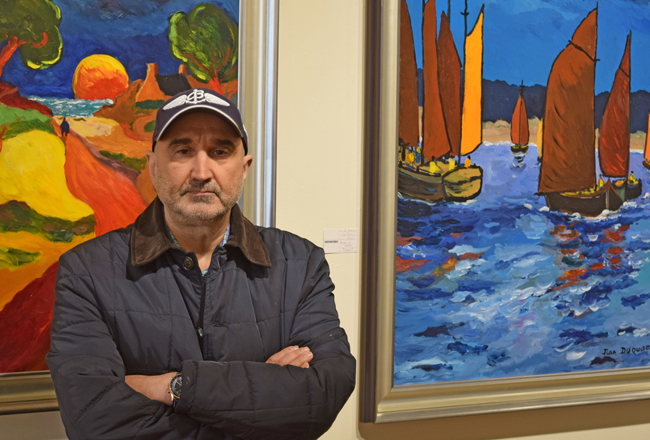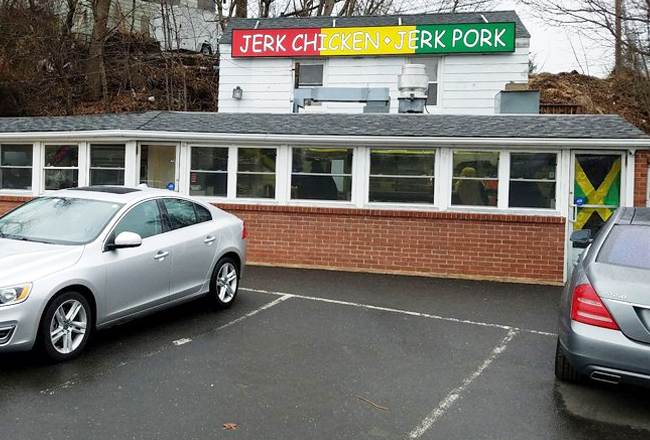As a rule, Claude Villani never gets any business at his Galerie Sono from passersbys who stop and ponder the art on display in the windows of his Norwalk exhibition venue. But there was a memorable exception.
“It happened one time,” said Villani, laughing at the recollection. “A guy saw a $25,000 Anne Packard painting and he said, ”˜I”™ll take that one in the window.”™”
And not unlike the deep-pocketed customer, Villani”™s presence in the Fairfield County art scene could be seen as something of an exception to the long-standing rule of what sells.

Photo by Phil Hall
“When I opened in 1999, I had a number of friends who had galleries in Greenwich and New Canaan and Westport, and a lot of it was traditional art,” he said. “It is what I used to say was ”˜the dog with the pheasant in its mouth”™ paintings. And I said that I was going to focus on contemporary art and they said, ”˜Good luck with that in Connecticut.”™”
Housed within a 6,000-square-foot space at 123 Washington St. in the heart of Norwalk”™s SoNo district, the gallery is an airy, brightly illuminated venue that accommodates the works of 10 to 14 artists at a time. Villani is particular about whose work gets displayed.
“To be in this gallery requires being in similar galleries across the country and world, and in museums,” he explained. “We don”™t do much with local artists. Not that we don”™t support local artists, but we are collector-driven and they want artists who are investment-ready.”
Galerie Sono also requires geographic exclusivity of its artists with radius clauses in their contracts. “If we carry Hunt Slonem, he”™s not going to show nearby,” Villani said.
Galerie Sono is now exhibiting works by Dennis Sheehan, Craig Mooney, Carmelo Blandino, Helen Zarin and Onyeka Ibe, and a reception celebrating Slonem”™s work is scheduled for March 24. Max Becker III, the gallery”™s director, observed that the venue was more interested in responding to customer preferences than forcing trends on its audience. “We have a nice variety of imagery, more representational as opposed to abstract, but that is dictated primarily on what we perceive to be the taste of the marketplace,” he said.
Villani, who operated galleries in The Hamptons and New Jersey”™s Somerset County before coming to Connecticut (and who also runs the SoNo Recording Group music label as a second business), culls his client base from a tristate pool of private collectors that he describes as a “virtual who”™s who of celebrities and high-profile financial people.” But unlike the aforementioned impulse buyer who liked what he saw in the window, Galerie Sono works patiently to match the buyer with the right art piece.
“One of the most important elements of the process is to educate the customer,” said Becker. “We want to find the proper space for a painting in the customer”™s home. To finalize the transaction, we bring the painting to the customer”™s home to see the painting in the space.”
While Galerie Sono offers Instagram views of its exhibits, Villani is not convinced that social media is the right place for choosing art. “I don”™t think that I can buy a piece of art that I can”™t see (in person),” he said. “It”™s like buying a car or a home ”“ you have to see it and experience it.”
In an age when digital messaging reigns, he still relies on old-fashioned direct mail. “We find direct mail is the best way to do it,” he added. “You get a card that comes in the mail that is beautiful and with all of the information on it. And we find a lot of people keep them and put them on their refrigerators.”
The gallery prices its works based on the per-square-inch measurements of each piece and the artist”™s visibility in the marketplace, and its fee structure is a graduated scale depending on the artist”™s reputation. While declining to offer specific revenue data, Villani pointed to his longevity in business as evidence of a successful operation.
“We have sold paintings for upwards of hundreds of thousands of dollars,” he said, adding that the gallery will also buy back paintings that it sold years ago to customers who are now seeking to update their collections.
As for his competition in the region”™s art world, Villani shrugged. “Today, it seems a lot have fallen away,” he said. “I don”™t even know who has a gallery out there right now.”




















